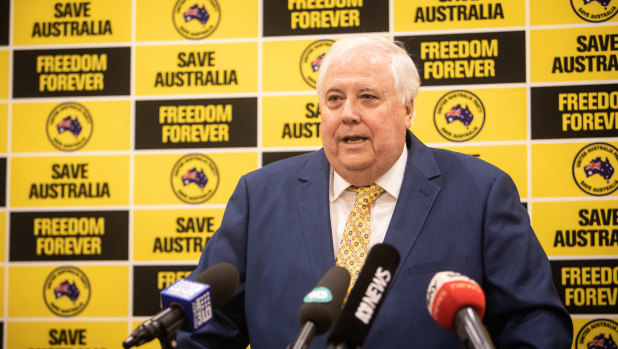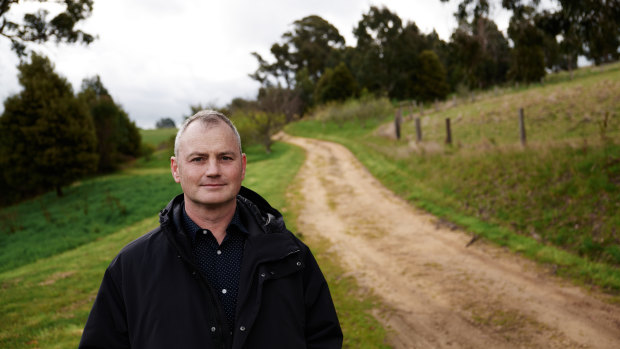- Exclusive
- Politics
- Federal
- Political donations
This was published 2 years ago
Elite donors call shots in political funding race
By David Crowe
A small club of elite donors has spent almost $1 billion in today’s dollars on donations over the past two decades, dominating funding for the major political parties and highlighting the influence of key insiders amid calls for reform to political finance laws.
New analysis shows the top 5 per cent of donors made up 76.4 per cent of all donations by dollar values over the period, with mining billionaire Clive Palmer emerging as the biggest single funding source.

Mining magnate and former federal MP Clive Palmer dominated the political donations pool.Credit: Scott McNaughton
The findings by the Centre for Public Integrity, a non-profit group of former judges and anti-corruption campaigners, are likely to intensify the debate over caps on donations when Labor unveils sweeping changes to donations law later this year.
“Big donations are distorting our political process,” said former NSW Supreme Court judge Anthony Whealy, KC, the chair of the Centre for Public Integrity.
“Our laws are allowing big money to fund our parties and elections. Given the reliance that the major parties have on these top donors, there is a real risk that they receive special access and yield undue influence on our decision makers.
“We urgently need a cap on political donations so that an average voter can match the donations of millionaires.”
Further donations worth tens of millions of dollars are due to be revealed on Wednesday when the Australian Electoral Commission publishes hundreds of scanned images of forms lodged for the last financial year, tipped to show a boost in funding ahead of the 2022 May federal election.
But the Centre for Public Integrity has questioned the disclosure regime because the major parties rely heavily on “associated entities” such as investment companies and foundations, which makes it difficult to know the ultimate source of cash flowing to election campaigns.
The findings about the past two decades are part of a new paper on the concentration in donations from 1999 to 2021, when the main political parties received about $1.3 billion in donations and the top 5 per cent of donors contributed $996.7 million of the total. The figures are presented in today’s dollars, adjusted for inflation.
“A tiny number of big-money contributors are dominating our political parties,” said Melbourne Law School professor Joo-Cheong Tham, a board member of the Centre for Public Integrity.
“We urgently need an overhaul of the federal political finance regime with the enactment of caps on contributions and spending.”
Advocacy group Transparency International issued annual findings on Tuesday that praised Australia for legislating the National Anti-Corruption Commission but pointed to weaknesses on campaign finance and called for donations caps and real-time disclosure.
The paper from the Centre for Public Integrity argues for policy changes including the disclosure of donations within a week at most times and within 24 hours of the payment during an election campaign.
The paper argues for an expansion of the definition of “donation” to include income from party fundraisers, corporate sponsorship of business forums and membership fees.
In a call that would stop Palmer and other big donors from dominating political funding, the group also calls for caps of $2000 per year for candidates and $5000 per year for parties.
But Climate 200 convenor Simon Holmes a Court, whose group raised about $13 million for independent candidates at the last election, warned that caps on donations could help the major parties.
“We have to be careful what we wish for,” he said.

Climate 200 founder Simon Holmes a Court, pictured on his Victorian farm, warns a donations cap may thwart independents.Credit: Kristoffer Paulsen
“Unless they are part of broader electoral funding reform, donation and expenditure caps keep out newcomers, and further entrench Australia’s political duopoly, which is exactly what those in power want.”
Special Minister of State Don Farrell has told this masthead he would introduce draft laws this year to deliver “greater transparency and greater representation” including an obligation on donors to report their payments in real-time.
An important change in Farrell’s plan is to reduce the threshold for disclosure from $14,800 to $1000 to ensure many more donations would have to be reported to the Australian Electoral Commission.
The new paper names the top 10 donors over the two decades since 1999 and names two of Palmer’s companies, Mineralogy with $110.3 million and Queensland Nickel with $24.2 million, on the list.
The biggest single donor to the Liberal Party on the list was the Cormack Foundation, which was established by Victorian Liberals in 1988, with $63.6 million.
Major donors to the Labor Party included Labor Holdings, with $62.4 million, and John Curtin House, with $49.9 million, and Labor Resources, with $24.1 million.
The biggest donors from the union movement included the Shop Distributive & Allied Employees Association, with $34.8 million, United Voice, with $33.1 million, the CFMMEU, with $25.9 million, and the Electrical Trades Union, with $23.8 million.
Cut through the noise of federal politics with news, views and expert analysis from Jacqueline Maley. Subscribers can sign up to our weekly Inside Politics newsletter here.